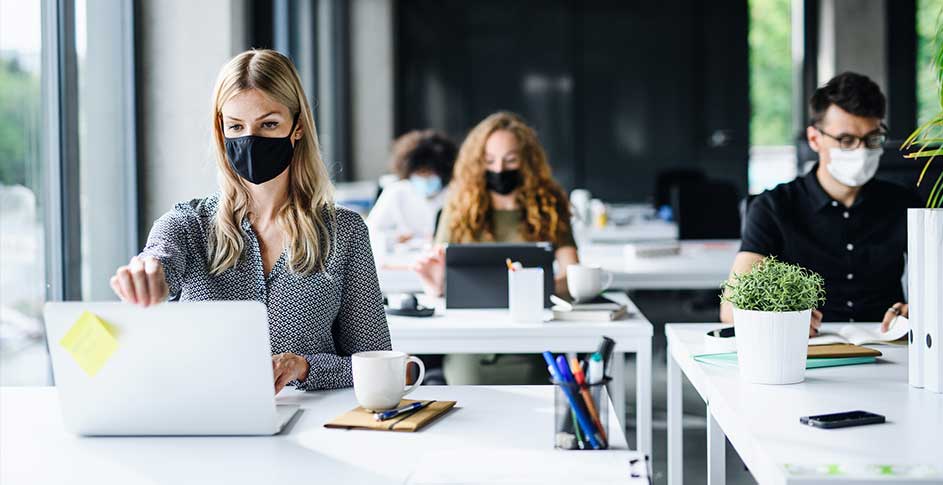We’ve previously explained the impact that indoor air quality has on your business’ bottom line. However, it's not just indoor contaminants you have to worry about. Without proper layered protections, outdoor pollution oftentimes becomes indoor pollution.
Why Does Outdoor Pollution Matter?
Outdoor air pollution matters to your business for 3 reasons:
1. Outdoor Air is Getting Worse
90% of nations — including the United States — have unhealthily polluted outdoor air. Yet much of the guidance surrounding poor air quality involves reducing exposure to the outdoors. If we are going to move into buildings to escape outdoor pollution, those buildings need to be a refuge.
2. Pollution Is More Dangerous Indoors
Once contaminants get trapped indoors, they are more likely to encounter your lungs. As our article on outdoor air standards describes, “Even with adequate ventilation, it's more difficult to dilute contaminants inside[...]Partially for this reason, many indoor contaminants are found at concentrations 2 to 5 times higher than outdoor air.”
3. Outdoor Pollution Impacts Your Bottom Line
A Stanford University article reports that air pollution costs the U.S. “roughly 5 percent of its yearly gross domestic product.” Part of this may be the loss of your workforce; per an article in Nature:
“Our best estimates of the US mortality burden associated with total PM2.5 exposure in the year 2012 range from ~230,000 to ~300,000 deaths. Indoor exposure to PM2.5 of outdoor origin is typically the largest total exposure, accounting for ~40 – 60% of total mortality[...]”
How Much Does Outdoor Air Pollution Affect Indoor Air Quality?
The relationship between indoor air and outdoor air changes constantly. Hence, the degree that outdoor contaminants impact indoor air quality (IAQ) varies. To give a few examples:
- A survey by the National Institute for Occupational Safety and Hygiene reports that outdoor contamination was the third most likely reason for sick building syndrome (SBS) complaints.
- A study of inner-city homes finds that while smoking is the worst source of pollution, “outdoor particle penetration” accounts for 1/4th of indoor PM2.5.
- A 2017 study of buildings in Daqing, China estimated that 70% of indoor particulate matter comes from outdoor sources.
How Do Outdoor Pollutants Get Indoors?
Outdoor contamination may enter your building in three ways:
1. Intentional Natural Ventilation
Intentional natural ventilation occurs via screen doors and open windows. At first glance, natural ventilation’s effect on IAQ seems obvious. If you open the window on a smoggy day, that smog full of harmful contaminants will drift inside.
Non-visible pollutants may pose a threat to your IAQ; therefore, trying to let in some “fresh” air without checking your local air quality report could do more harm than good.
2. Mechanical Ventilation
In commercial buildings, mechanical ventilation is most often represented by the HVAC system. A 2006 USDOE report found that “delivery of outdoor pollutants” is “largely determined by the details of HVAC design and operation.”
For instance, if your HVAC system draws outdoor air in without filtration, any contaminants in the outdoor air will begin to cycle through your HVAC system. This may also occur if the intake vent for the building is near a source of contamination.
3. Infiltration
Unintentional natural ventilation — or infiltration — occurs via cracks around doors and windows due to wind, pressure, and density differences.
Infiltration can have a significant impact on indoor contaminants. According to a 2022 paper from the Technical University of Madrid (UPM,) “All the effects of infiltration can cause an increase of up to 12% in indoor NO2 concentrations.”
What External Factors Affect Ambient Pollution Risk?
There are two external factors that contribute to the infiltration of pollution indoors:
1. Weather
Since warm air is less dense than cool air, any temperature changes can alter the pressure between your building and the outdoors. When your building experiences negative pressure, outdoor air is more likely to flow inside.
This may be exacerbated by tall buildings, creating what is called the “stack effect.” As an EPA guidebook explains:
“As heated air escapes from upper levels of the building, indoor air moves from lower to upper floors, and replacement outdoor air is drawn into openings at the lower levels of buildings. Stack effect airflow can transport contaminants between floors by way of stairwells, elevator shafts, utility chases, or other openings.”
Weather also affects the types of pollutants that are present. Per UPM, “the impact of infiltration is greater on NO2 than on PM2.5 except in the winter months when outdoor concentrations of PM2.5 are higher than those of NO2.”
2. Location
Your location also determines what outdoor pollutants enter your building. Vehicle exhaust is one major source of exposure to nitrogen oxides and PM2.5. Consequently, the air in cities is particularly susceptible to poor air quality. Urban air quality is impacted by airports, exhaust from other buildings, and construction.
According to a 2021 literature review, a study of a school in Chennai found that most of the indoor particulate matter is due to traffic. The same paper reports a Korean study that “concluded that preschools in urban areas have considerably higher indoor pollution levels as compared to the outside and rural preschool environments.”
Why Does Outdoor Pollution Require Multiple Solutions?
There’s no fix-all for controlling indoor contaminants; a building must use multiple, layered protections involving ventilation, filtration, air cleaning, and source control. The same precautions must be used to combat contamination from outdoor air.
Some common mistakes include:
1. Sealing Alone Can Make Things Worse
Sealing your building is often sold as a magical solution — dealing with infiltration and lowering energy consumption in one fell swoop. However, sealing your building without improving ventilation can make your air quality worse.
For instance, the 2021 literature review found higher levels of CO2 in bedrooms ventilated by air conditioners — resulting in SBS symptoms for some occupants. It also found that rooms ventilated naturally had higher particle counts, further emphasizing the need for multi-pronged solutions.
2. HVAC Systems Can Cause Their Own Problems
HVAC-related measures are rarely perfect. The EPA suggests that there will always be “some location that is under negative pressure relative to the outdoors.” Even with a filter, contamination will use the HVAC system to move from one area of the building to the other.
Certain types of HVAC systems can be programmed to avoid bringing in outdoor air during periods of high risk. Supplementing such modifications with portable air purifiers can help mitigate any outdoor contaminants that enter the building during increases in ventilation.
HVAC systems can also harbor living contaminants. According to the CDC:
“If [HVAC] systems are not appropriately maintained, ventilation air filters can become saturated leading to potential microbial growth and odor concerns. Microbial growth can also result from stagnant water in drain pans or from uncontrolled moisture inside of air ducts and cooling coils.”
Layered air purification technologies can help close the gap on these HVAC oversights. If you’d like to learn more about layered solutions for indoor and outdoor contaminants, please see our blog on ventilation, filtration, and air cleaning.

